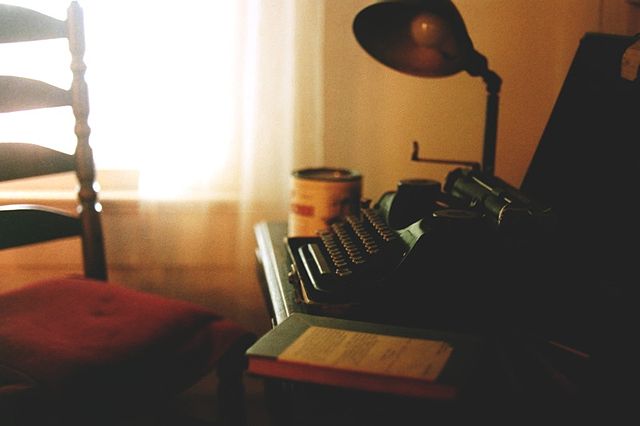
File:TheFaulknerPortable.jpg

| |
This is a file from the Wikimedia Commons. Information from its description page there is shown below.
Commons is a freely licensed media file repository. You can help. |
Summary
| Description | The "Faulkner portable": American novelist William Faulkner’s (1897-1962) Underwood Universal Portable typewriter, resting on a tiny desk his stepson helped him build. This space at Rowan Oak, the author's home, was part of the back porch until Faulkner spent part of a Random House advance to enclose it in 1952, long after he had written his seminal Compson and Sartoris family novels. He insisted that this room not be called his "study." According to biographer Joseph Blotner, "he did not study in it, so there was no sense in calling it that. It was the 'office,' the traditional name for the room in the plantation houses where the business was transacted." As to the typewriter itself, Underwood introduced its Universal Portable in the mid-l930's among a full line of portables such as Champion, Noiseless Portable and Junior. Faulkner had a habit of buying used portables locally, wearing them out, then trading them in on more used portables. This Underwood was one of at least three typewriters in Faulkner`s possession at the time of his death (the University of Virginia has one, too). So, this is no more "the" typewriter any more than those square carpenter`s pencils next to it are "the" pencils. Had Faulkner lived a few more years, this machine would have met the same fate as the rest. Still, the room has a resonance. BOOK magazine was publishing an article of mine on "Yoknapatourism," and thinking (mistakenly) that the editors hadn`t already selected a photographer, I returned to Oxford on a rainy October afternoon to make my own pictures for submission. The travel piece was eventually illustrated with sunny-day brochure shots, but I was happy to keep this one for myself. There was no direct lighting within the office, so I let the film take its time, soaking up faint incandescent glow from the library and main hallway, which neatly balanced the cloudy daylight. I used the camera`s timer so my hand wouldn't jostle the tripod, and I even backed out of the room--in part to let the scarce light do its work and, I think, because I wanted Faulkner`s office truly vacant. Trivia: the book next to the typewriter is the 1939 edition of Writer's Market. Thanks to Bill Griffith, curator of Rowan Oak, for letting me past the Lucite wall and to Milly Moorhead West for lending me the tripod. - Gary Bridgman |
| Date | October 2000 |
| Source | own work, http://www.southsideartgallery.com |
| Author | Gary Bridgman |
| Permission ( Reusing this file) |
credit to read Gary Bridgman, southsideartgallery.com |
Licensing
|
File usage
Metadata
| Camera manufacturer | Canon |
|---|---|
| Camera model | Canon EOS DIGITAL REBEL |
| Exposure time | 1/30 sec (0.033333333333333) |
| F-number | f/3.5 |
| ISO speed rating | 125 |
| Date and time of data generation | 15:41, 26 May 2006 |
| Lens focal length | 28 mm |
| Orientation | Normal |
| Horizontal resolution | 72 dpi |
| Vertical resolution | 72 dpi |
| Software used | QuickTime 7.1.3 |
| File change date and time | 22:09, 20 February 2007 |
| Exif version | 2.2 |
| Date and time of digitizing | 15:41, 26 May 2006 |
| Image compression mode | 3 |
| Shutter speed | 4.9068908941756 |
| APEX aperture | 3.6147157190635 |
| Exposure bias | 0 |
| Maximum land aperture | 3.6147157190635 APEX (f/3.5) |
| Metering mode | Pattern |
| Flash | Flash did not fire, compulsory flash suppression |
| Colour space | sRGB |
| Focal plane X resolution | 3,443.9459459459 |
| Focal plane Y resolution | 3,442.0169491525 |
| Focal plane resolution unit | inches |
| Sensing method | One-chip colour area sensor |
| Custom image processing | Normal process |
| Exposure mode | Auto exposure |
| White balance | Auto white balance |
| Scene capture type | Standard |
Want to know more?
SOS Childrens Villages chose the best bits of Wikipedia to help you learn. By supporting vulnerable children right through to adulthood, SOS Children's Villages makes a lasting difference to the lives of thousands of people. Education is a key part of our work, and our schools provide high-quality teaching to the children in our care. Have you heard about child sponsorship? Learn more...

